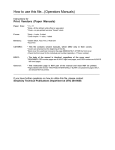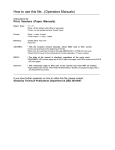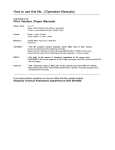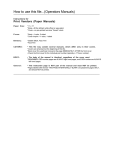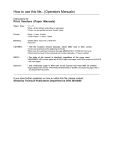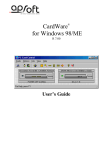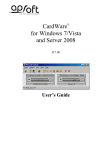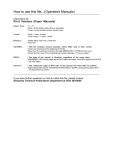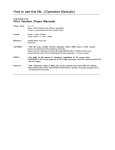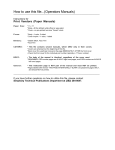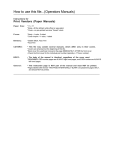Download Simplicity 1692978 Operator`s manual
Transcript
How to use this file...(Operators Manuals) ————————————————————————————————————————————––– Instructions for Print Vendors (Paper Manuals) Paper Size: * 11 x 17 * Body—50 lbs brilliant white offset or equivalent. * Cover—on pre-printed two-tone “Swash” stock. Press: * Body—1-color, 2-sided * Cover imprint —1-color, 1-sided Bindery: * Saddle Stitch, Face Trim * Face Trim COVERS: * This file may contain several manuals, which differ only in their covers. * Covers are all present at the beginning of this file. * Back cover for a particular manual is the page IMMEDIATELY AFTER the front cover. • Check the front cover for the individual part number (typically a 171xxxx number). BODY: • The body of the manual is identical, regardless of the cover used. * REMEMBER: ODD number pages are ALWAYS right hand pages, and EVEN number are ALWAYS left hand pages. General: * This instruction page is NOT part of the manual and must NOT be printed. • Pages labeled with the text “THIS PAGE INTENTIONALLY BLANK” are placement pages ONLY, and should NOT be printed. ————————————————————————————————————————————––– THIS PAGE INTENTIONALLY BLANK OPERATOR’S MANUAL 520 / Snow Tackler Series Mfg. No. 1692917 1692918 1692977 1692978 1692979 1692980 1692981 1692984 1692985 1692986 1692991 1692992 1693166 Description 520M, 5HP Snowthrower 520E, 5HP Snowthrower Green Bay Packers Snowthrower Minnesota Vikings Snowthrower Chicago Bears Snowthrower Detroit Lions Snowthrower Pittsburgh Steelers Snowthrower New England Patriots Snowthrower New York Jets Snowthrower St. Loius Rams Snowthrower Cleveland Browns Snowthrower New York Giants Snowthrower 520M, 5HP Snowthrower (Export) 1717862-01 Superceedes 1716679 Rev 1/2003 TP 100-2077-01-SW-S MANUFACTURING, INC. 500 N Spring Street / PO Box 997 Port Washington, WI 53074-0997 www.simplicitymfg.com © Copyright 2003, Simplicity Manufacturing, Inc. All Rights Reserved. Printed in USA. Table of Contents Regular Maintenance Removing Belt Cover ............................................12 Lubrication ............................................................12 Troubleshooting & Service Troubleshooting ....................................................13 Removing Engine Cover .......................................13 Auger Control Cable Adjustment ..........................14 Carburetor Adjustment (Ref. only) ........................14 Replacing the Drive Belt .......................................15 Replacing the Scraper Blade ................................15 Servicing the Spark Plug.......................................15 Appendices Specifications ........................................................16 Parts & Accessories ..............................................16 Technical Manuals ................................................16 Safety Rules & Information General ...................................................................2 Preparation .............................................................2 Operation ................................................................3 Maintenance & Storage ..........................................3 Safety Decals ..........................................................4 International Symbols .............................................4 Assembling the Snowthrower ....................................5 Controls & Operation Snowthrower Controls.............................................6 Engine & Starting Controls......................................7 General Operation ..................................................8 Checks Before Each Start-Up .................................8 Mixing Fuel..............................................................9 Starting the Engine ...............................................10 Stopping the Engine..............................................10 Operating the Snowthrower ..................................11 Snowthrowing Tips................................................11 After Each Use ......................................................11 Off-Season Storage ..............................................11 Starting After Storage ...........................................11 For easy reference, please record the information on the chart below. WARNING You must read, understand and comply with all safety and operating instructions in this manual before attempting to set-up and operate your snowthrower. The Equipment Reference Data can be found on the identification tag located on the unit’s rear frame. (Refer to the Engine Owner’s Manual for location of engine information serial number.) Failure to comply with all safety and operating instructions can result in loss of machine control, serious personal injury to you and /or bystanders, and risk of equipment and property damage. The triangle in the text signifies important cautions or warnings which must be followed. EQUIPMENT REFERENCE DATA Model Description/Number M/N (Manufacturer’s Number) S/N (Serial Number) Dealer Name Date Purchased WARNING ENGINE REFERENCE DATA Engine exhaust from this product contains chemicals known, in certain quantities, to cause cancer, birth defects, or other reproductive harm. Engine Make/Model 1 Engine ID/Serial Number Safety Rules & Information WARNING WARNING This unit is a “single-stage” snowthrower. To avoid serious injury, do not put your hands into the auger housing or discharge chute. If auger stalls or chute becomes plugged, use the following procedure to remove objects or clear the chute: The auger feeds the snow back into the housing and throws the snow out the discharge chute. If bodily contact is made with the auger or impeller when they are rotating, severe personal injury will occur. 1. 2. 3. 4. 5. Release the Auger Control. Shut off the engine. Remove the Engine Key. Wait for moving parts to stop. Use a narrow board to remove foreign objects and clear the chute or auger. Never put your hands into the auger or discharge chute. 6. If servicing is needed, remove cover and disconnect spark plug wire. To avoid injury, keep others and yourself away from the auger and the discharge chute whenever the engine is running. Read and follow all of the safety rules and warnings in this manual. GENERAL PREPARATION • Read the Operator’s Manual carefully. Be thoroughly familiar with all controls and proper equipment use. • Never attempt to make any adjustment while engine is running. • Never allow children to operate the machine. Do not allow adults to operate it without proper instruction. • Thoroughly inspect the area where the snowthrower is to be used and remove all objects such as door mats, sleds, boards, wires and sticks. • Keep the area of operation clear of all persons, particularly small children and pets. • Disengage all clutches (release Auger Control lever) before starting engine. • Never discharge material toward any person or pet. • Do not operate snowthrower without wearing proper winter clothing. Wear footwear which improves footing on slippery surfaces. • Make sure: a. snowthrower is in good operating condition; b. all safety devices and shields are in place and working; • Handle gasoline with care - it is highly flammable. a. Use approved gasoline container. c. all adjustments are correct. b. Never remove the fuel tank cap or add gasoline to a running or hot engine. c. Never fill the fuel tank indoors. d. Wipe up spilled gasoline. • Do not run engine indoors. Exhaust fumes are deadly. 2 Safety Rules & Information OPERATION MAINTENANCE & STORAGE • Keep hands and feet away from rotating parts. Keep clear of discharge opening at all times. • Keep all nuts, bolts and screws tight to ensure that the equipment is in safe operating condition. • Always clear snow up and down the face of slopes, never across the face. Use extreme caution when changing direction on slopes. Do not attempt to clear slopes over 17.7% (10o). • Never store equipment with gasoline in the tank in a building where fumes may reach an open flame or spark. Allow the engine to cool before storing in any enclosure. • Use extreme caution when operating on or crossing drives, walks or roads. Stay alert for hidden hazards and traffic. • Always refer to the Operator’s Manual for important details if snowthrower is to be stored for an extended period. • Be especially careful not to touch snowthrower parts which might be hot from operation. Allow such parts to cool before attempting to maintain, adjust or service. • Run auger drive a few seconds after completion of throwing snow to help clear out snow and prevent icing and freeze-up on unit. • If unit starts to vibrate abnormally, disengage drives and stop the engine. Check immediately for the cause. Vibration is generally a warning of trouble. • Before leaving operator’s position for any reason: - shut off engine, - remove the Engine Key and - wait for all moving parts to stop. • Before cleaning, repairing or inspecting the unit, make certain all moving parts have stopped. Remove the key to prevent accidental starting. • Always use a grounded, 3-wire plug receptacle for electric starting. • Adjust snow discharge angle for safe flow when operating near glass enclosures, automobiles, window wells, dropoffs, etc. • Do not overload machine capacity by clearing snow at too fast a ground speed. • Never operate machine at high transport speeds on slippery surfaces. Use care when backing up. • Disengage Auger Control when transporting or not in use. • Never operate the snowthrower without good visibility or light. Always be sure of your footing. • Do not change the engine governor settings or overspeed the engine. • Never direct the discharge chute at bystanders; nor allow anyone in front of the unit while it is operational. • Never operate this machine without all of the proper guards or other safety protective devices in place. 3 Safety Rules & Information SAFETY DECALS Safety warning decals are placed at strategic locations on the snowthrower as a constant reminder to the operator of the most important safety precautions. All warning, caution and instructional messages on your snowthrower should be carefully read and obeyed. If any of these decals are lost or damaged, replace them at once. They can be purchased from your local dealer. Part No. 1716672 Auger Control Decal Part No. 1716669 Main Dash Decal (Electric Start Models) Part No. 1716671 Warning Decal Part No. 1716670 Main Dash Decal (Manual Start Models) DANGER DANGER AVOID INJURY FROM ROTATING BLOWER! AVOID INJURY FROM ROTATING AUGER! Shut off engine before unclogging discharge chute. 1716532 Keep hands, feet, and clothing away. 1716533 Part No. 1716533 Discharge Chute Danger Decal Part No. 1716532 Auger Danger Decal International Symbols FAST CHOKE IGNITION KEY SLOW PRIMER RUN STOP ELECTRIC START 4 Assembling the Snowthrower TOOLS REQUIRED • Socket or Wrench Set A • Pair of Pliers ASSEMBLY PROCEDURE C If your unit was not previously assembled, see Figures 1 and 2, and follow the steps below to assemble the unit: D 1. Install the discharge chute on to the rotating ring located on the auger housing. Secure with the three 5/16 inch carriage bolts, flat washers and nylok nuts found in the parts bag (the bolt heads go to inside of of the rotating ring, with washers and nuts on the outside). Note, install the rear bolt first for easier alignment. E B 2. Tighten bolts securely with a wrench. Figure 1. Assembly of Discharge Chute A. Discharge Chute D. Nuts B. Carriage Bolts E. Rotating Ring C. Washers 3. Lift up folding handle to align it with lower handle and tighten the wing knobs securely as shown in Figure 3. The snow thrower is now ready for operation once the fuel tank has been filled with the properly mixed gasoline and two cycle oil. A B Figure 2. Handles A. Handle Figure 3. Lift Handles and Lock Wing Knobs B. Wing Knobs 5 Controls & Operation SNOWTHROWER CONTROLS A Auger Control C A. Auger Control - This control engages and disengages the auger. Pull the control back against handle to engage the auger, (this will pull snowthrower forward if auger is in contact with the ground). Release the Auger Control to stop rotation of auger. B Deflector Controls B. Chute Direction Control - The Chute Direction Control (B, Figure 4) allows the discharge chute to be rotated to throw snow in the desired direction. Snow may be thrown at any angle from straight left to straight forward, to straight right. C. Chute Deflector - Controls the distance snow is thrown. Tilting the Chute Deflector (C, Figure 4) UP provides a higher stream and greater distance, while tilting the deflector DOWN provides a lower stream and less distance. Figure 4. Snowthrower Controls 6 A Auger Control Engages auger when pulled back, and disengages auger when released. B Chute Direction Control Rotates discharge chute to desired direction C Chute Deflector Controls vertical angle snow is thrown. Controls & Operation ENGINE & STARTING CONTROLS C NOTE: Throttle - This snow thrower does NOT have a throttle for controlling operating speed of engine. The engine governor maintains operating speed for varying snow removal conditions. B Electric Start Units Only A. Electric Start Button - The Electric Start Button (A, Figure 5) activates an electric starter mounted to the engine, eliminating the need to pull the starter handle. The Electric Start Button operates on 120 Volts AC, which is provided by connection to the extension cord provided with units equipped with this feature. Connect this extension cord ONLY to a properly grounded 3 prong electrical outlet. E All Models F B. Fuel Tank Cap - Cover fuel tank & provides venting ability to prevent vapor lock. A D C. Starter Handle - The starter handle (C, Figure 5) connects to a starter cord to manually start the engine. Pulling starter handle rapidly spins the engine crankshaft, cycles the engine, and generates the spark necessary for starting the engine. Figure 5. Engine Controls A D. Primer Button - When pressed, the Primer Button (D, Figure 5) provides initial fuel to help start a cold engine. Normally, pressing the primer button twice will provide enough fuel to start a cold engine. E. Engine Key - Insert key in switch and turn key to ON position when starting engine. To stop engine, turn key to OFF position. F. Choke Control - The is control (F, Figure 5) adjusts the fuel/air mixture, and is used to help start a cold engine by providing a richer mixture.Once the engine is warm and running smoothly, the Choke Control should be set to the off position to provide a normal air/fuel mix. 7 Electric Start Button (Optional) Activates electric starter B Fuel Tank Cap Covers fuels tank and provides venting to prevent vapor lock C Starter Handle Used to start engine D Primer Button Primes carburetor for faster cold starting. E Engine Key Prevents starting of engine without key. Stops engine when removed. F Choke Control Adjusts air/fuel mixture Controls & Operation GENERAL OPERATION CHECKS BEFORE EACH START-UP WARNING 1. Make sure all safety guards are in place and all nuts, bolts and clips are secure. To avoid serious injury, do not put your hands into the auger housing or discharge chute. If auger stalls or chute becomes plugged, use the following procedure to remove objects or clear the chute: 2. Check the fuel supply. Fill the tank no closer than 1/4 to 1/2 inch of top of tank to provide space for expansion. See your engine Owner’s Manual for fuel recommendations. 1. 2. 3. 4. 5. Release the Auger Control. Shut off the engine. Remove the Engine Key. Wait for moving parts to stop. Use a narrow board to remove foreign objects and clear the chute or auger. Never put your hands into the auger or discharge chute. 6. If servicing is needed, remove cover and disconnect spark plug wire. 3. Check the Auger Control (see A, Figure 4) for proper operation. If adjustment is required, see the Service section (pages 13-15) for procedures. 4. Check the Chute Direction Control (B, Figure 4) for proper operation. The discharge chute should rotate freely in both directions. See the Service section for adjustment procedures and troubleshooting. 5. Check the Chute Deflector (C, Figure 4) for proper operation. The deflector should pivot freely up and down. See the Service Section for procedures. WARNING 6. Position the chute at the desired starting direction and set the deflector at the desired angle. For your safety, operation on slopes should be in an up and down direction only. If it becomes necessary to move across the face of a slope, use caution and do not blow snow. Be very careful when changing direction on a slope. Proper winter footwear is recommended for the operator to help prevent slipping. Never attempt to clean snow from excessively steep slopes. The maximum slope for any operation is 17.7% (10º). WARNING Gasoline is highly flammable and must be handled with care. Never fill the tank when the engine is hot or running. Always move outdoors to fill the tank. Keep snowthrower and gasoline away from open flame or spark. 8 Controls & Operation FUEL AND OIL MIXTURE FUEL TO OIL MIXTURE CHART (50:1) U.S. The snowthrower uses a two cycle engine that requires a mixture of fuel (gasoline) and oil for lubrication of engine bearings and other moving parts. Imperial Metric Gasoline 2 Cycle Oil Gasoline 2 Cycle Oil Gasoline 2 Cycle Oil Gallons Ounces Gallons Ounces Liters Milliliters The correct fuel/oil mixture ratio for the five horsepower engine is 50 to 1. Use fuel/oil mixture chart shown. NOTE: To prevent damage to engine, carefully observe recommended fuel to oil mixing ratio and procedures. 1 2.5 1 2.8 4 80 ml 2 5 2 5.6 8 160 ml 5 13 5 14.1 20 400 ml • Gasoline and oil must be premixed in a clean fuel container. • Always use fresh, unleaded, winter grade fuel WARNING • Never put plain, unmixed fuel into fuel tank. Shake fuel container each time before filling fuel tank. Gasoline is highly flammable and must be handled with care. Never fill the tank when the engine is hot or running. Always move outdoors to fill the tank. Keep snowthrower and gasoline away from open flame or spark. • Never use “stale” fuel left over from last season or stored for long periods. • DO NOT USE MULTI VISCOSITY OILS, SUCH AS 10W-30 or 10W-40. PROPER FUEL MIXING PROCEDURE 1. Fill approved clean fuel container one quarter full with fresh unleaded fuel - one quart (one liter) in a one gallon (4 liter) container. A B C D 2. Pour recommended amount of high quality two cycle oil — 2.5 ounces (80 ml) into fuel container for one gallon (4 liters) of fuel. (NOTE: DO NOT USE MULTI VISCOSITY OILS, SUCH AS 10W-30 or 10W-40.) 3. Reinstall cap on the fuel container and shake container vigorously so oil mixes with gasoline. 4. Unscrew cap and fill container with fuel. Shake container again. 5. Remove fuel tank cap and carefully pour mixed fuel into the fuel tank, filling to 1/2 inch (1.5 cm) below filler neck to allow room for expansion. Never put plain, unmixed fuel into fuel tank. Shake fuel container each time before filling fuel tank. Figure 6. Proper Fuel Mixing Procedure A. Fill Container with 1 Quart (1 Liter) of fuel B. 2.5 Ounces (80 ml) of two-cycle oil C. Combine in container, then shake container D. Additional fuel brings total to 1 Gallon (4 liters) 9 Controls & Operation STARTING THE ENGINE DANGER NOTE: The snow thrower engine is designed to operate at cold temperatures. Avoid operating the snow thrower if air temperature is 40° C or warmer since engine may vapor lock and stop running after a short time. Engine will be difficult to start in warm weather. Never run engine indoors or in enclosed, poorly ventilated areas. Engine exhaust contains CARBON MONOXIDE, an ODORLESS and DEADLY GAS. Electric Starting Steps Manual (Recoil) Starting Steps Note: The electric starter is designed to operate on 120V AC household current, using power cord supplied with electric start snow thrower. When using power cord, match wide blade of plug to wide slot of receptacle. 1. Insert engine key in switch and turn key to the ON position. 1. Insert engine key in switch and turn key to the ON position. 3. Push the Primer Button two times if engine is cold. (Do not prime a warm engine.) 2. If engine is cold, move choke control lever to the ON position. (Do not choke a warm engine). 4. Grasp starter rope handle and slowly pull out rope until resistance is felt. Allow rope to rewind slowly, then pull rope out rapidly to start engine. Let rope return slowly to starter. 2. If engine is cold, move choke control lever to the ON position. (Do not choke a warm engine). 3. Push the Primer Button two times if engine is cold. (Do not prime a warm engine.) NOTE: If engine does not start after three pulls, push primer bulb once and again pull starter rope. 4. Plug power cord for starter into receptacle on starter switch, then plug other end into a 120Volt AC household receptacle. DO NOT use an extension cord with the electric start power cord supplied. 5. After engine starts and gradually warms up, move choke lever to the OFF position. Be prepared to move choke lever to the ON position if engine falters during warm up. CAUTION Be sure there is no moisture present on cord ends or receptacles when plugging cord into receptacle. 6. Allow engine to warm up before beginning snow thrower operations. The engine will operate at full throttle when thoroughly warmed up. 5. Push starter button to crank engine. DO NOT crank engine for more than a total of 15 seconds without allowing electric starter to cool for 10 minutes before additional cranking is attempted. Electric starter can be severely damaged if recommended starter operating limitations are not observed. 7. To stop engine, turn Engine Key to the OFF position. STOPPING THE ENGINE 1. Release the Auger Control. NOTE: Do not push primer button while engine is being cranked. 2. Turn Engine Key to the OFF position. 3. Remove the key from the switch if you are leaving the operating position or will be making adjustments or repairs. (NOTE: Allow the unit to cool before storing or making any adjustments or repairs.) 6. Release starter button when engine starts and gradually move choke lever to the OFF position. NOTE: Always disconnect power cord from household receptacle first, then unplug from starter switch. If you will be storing the unit for the season, see the STORAGE section for instructions on properly preparing the unit for long-term storage. 7. Disconnect power cord from household receptacle and then from starter switch on snow thrower. Store cord in a dry, convenient place. 8. To stop engine, turn Engine Key to the OFF position. 10 Controls & Operation OPERATING THE SNOWTHROWER OFF-SEASON STORAGE Before operating snowthrower, review the Checks Before Each Use under General Operation on page 8 of this manual. Before you store your snowthrower for the off-season, read the Maintenance and Storage instructions in the Safety Rules section and take the following precautions: NOTE: Gasoline, if permitted to stand unused for extended periods (30 days or longer), may develop gummy deposits which can adversely affect the engine carburetor and cause engine malfunction. To avoid this condition, add Simplicity Gasoline Stabilizer to the fuel tank, or drain all fuel from the system before placing unit in storage. 1. Rotate the discharge chute to the desired direction. 2. Pull the Auger Control back against the handle to engage the auger. NOTE: The snow thrower will be pulled forward by the auger when the auger contacts the ground or with the snow to be thrown. 1. Prepare your snowthrower engine for storage as instructed in the Engine Owner’s Manual. 3. Begin snow removal by clearing a path down the center of walk or driveway, then gradually widen path, throwing snow off to both sides. 2. Lubricate the snowthrower as described in the LUBRICATION section of this manual. 4. Release the Auger Control to stop both the auger and the forward motion of the snowthrower. 3. Clean the snowthrower thoroughly. Coat exposed bare metal parts with a quality paint (available from you dealer) or a light film of grease, oil or automotive wax. WARNING 4. Store snowthrower in the wheels down, operating position. Note: If the unit is stored in any other position, fluids may leak. Do not use snow thrower on surfaces above ground level, such as the roof of a building. 5. Store the unit in a protected area and cover. SNOWTHROWING TIPS STARTING AFTER STORAGE Varying snow conditions will affect performance of snow thrower. The snow thrower should be allowed to move into the snow at it's own pace. 1. Remove the spark plug and wipe dry. Then reinstall plug. 2. Fill fuel tank with fresh gasoline (unless a fuel stabilizer was used). 3. Check to be sure engine fins are clean and air flow is unobstructed. 4. Start the engine outdoors. Warm up engine by running at SLOW speed for a a few minutes before running at FAST speed, or blowing snow. Wet, heavy snow — When clearing wet, heavy snow, the forward movement of the snowthrower may have to be slowed by pushing down on handle while allowing engine to operate at full throttle. Do not operate on gravel or crushed rock surfaces. Avoid picking up this type of material with auger since damage to unit could result and particles can be discharged with considerable force that could cause serious injury. 5. Check the operation of all the controls. If necessary, lubricate the snowthrower to improve operation of the chute control. Always be alert to hidden hazards that might be struck by the auger. Should a foreign object be struck by the auger, immediately stop the engine and inspect machine for any damage. Repair damage before continuing operation. AFTER EACH USE Allow snow thrower to run a few minutes after clearing snow to reduce the likelihood of parts freezing while machine is not is use. If you will be storing the unit for the season, see the STORAGE section for instructions on properly preparing the unit for long-term storage. 11 Regular Maintenance Removing Belt Cover In order to perform proper lubrication, it is necessary to remove the Belt cover from the lower left of the snowthrower. Screws 1. Remove the Engine Key from the switch. 2. Remove the fours screws securing the belt cover (see Figure 7). 3. Remove the cover. Figure 7. Removing Belt Cover 4. Perform lubrication (see below). 5. Reinstall belt cover (reverse steps 3 to 1 above.) LUBRICATION Note: The drive pulley end of auger shaft is supported by a sealed ball bearing and requires no lubrication. The ball bearing on other end of auger shaft is also sealed, and will not require lubrication. Lightly Oil • A few drops of oil should be placed on wheel hubs occasionally to keep wheels turning freely. Figure 8. Lubrication points • Apply oil to pivot points of auger control periodically, wiping off any excess oil. • A couple of drops of light machine oil applied to upper end of auger control cable will assure free movement of cable through outside casing. Wipe off any excess oil. Pivot Point • Remove belt cover and lightly apply oil to the pivot point for idler pulley arm. BE CAREFUL NOT TO GET OIL ON BELT OR PULLEYS. Grease Figure 9. Lightly oil pivot point • At the beginning of each snow throwing season, remove discharge chute and generously lubricate steel flange at back of rotating ring with light grease. Rotate ring with crank to distribute grease. Lubricate Flange Engine Lubrication The two cycle engine used in this snow thrower is lubricated by the fuel and oil mixture. Observe recommended fuel to oil mixture ratio shown on page 9. Figure 10. Grease the Discharge Chute Ring 12 Troubleshooting & Service TROUBLESHOOTING Problem Possible Cause Remedy Engine fails to start 1. Key is OFF 2. Failure to prime cold engine 3. Out of fuel 4. Choke OFF - cold engine 5. Engine flooded 6. Spark Plug not sparking 1. Turn Key to the ON position 2. Press primer button twice and restart. 3. Fill fuel tank 4. Turn Choke to ON. 5. Turn Choke to OFF; try starting 6. Check Gap. Gap plug, clean electrode, or replace as necessary 7. Drain tank (Dispose of fuel at an authorized waste facility). Fill with fresh fuel mixture. 7. Water in fuel, or old fuel Engine starts hard or runs poorly 1. Fuel mixture too rich 2. Spark plug faulty, fouled, or gapped incorrectly 3. Water in fuel, or old fuel 4. Gas cap vent hole plugged Unit does not throw snow 1. Loose or broken drive belt 2. Incorrect control cable adjustment 3. Discharge chute clogged, foreign object lodged in auger 4. Broken control cable 1. Move choke to OFF position 2. Clean and gap, or replace 3. Drain tank (Dispose of fuel at an authorized waste facility). Fill with fresh fuel mixture. 4. Clean vent hole or replace cap 1. Adjust or replace belt 2. Adjust Auger Control cable 3. Stop engine, remove key and clean out discharge chute 4. Replace cable Auger does not stop turning when control is released 1. Incorrect control cable adjustment 1. Adjust Auger Control cable Excessive vibration 1. Loose parts or damaged auger 1. STOP engine and REMOVE the key, tighten all hardware. If vibration continues, see your dealer. Note: For repairs beyond the minor adjustments listed above, please contact your local Simplicity dealer. REMOVING ENGINE COVER Remove Fuel Tank Cap Note: In many of the following adjustment and service tasks, it will be necessary to remove and reinstall the engine cover. To remove the cover, proceed as follows: 1. Remove the Engine Key from the switch. 2. Remove the two rear fasteners securing the back of the cover housing. (Figure 11). 3. Remove the fuel tank cap. 4. Remove the cover (see Figure 12 on page 14). 5. Temporarily reinstall the fuel tank cap. 6. Perform the adjustments or service desired. 7. Reinstall the cover by reversing the removal steps. Note: The tabs at the lower front of the cover must be positioned correctly. Remove two rear fasteners securing cover WARNING To avoid the possibility of serious bodily injury when performing adjustments, maintenance or lubrication, stop engine and remove key from switch. Figure 11. Remove and/or loosen Cover Screws 13 Troubleshooting & Service Lift Cover from Rear of unit Locknuts Spring Insert front tabs first when reinstalling cover. Align rear tabs & side of cover when reinstalling. Figure 12. Cover Removal & Installation Figure 13. Auger Control Cable AUGER CONTROL CABLE ADJUSTMENT Adjusting the Cable The length of the auger control cable is adjustable. However, it will seldom be necessary to change the cable length since the operating tension on the drive belt is maintained by the spring on the end of the cable. 2. Locate and loosen the lower locknut securing the auger control cable (shown in Figure 13). 1. Remove the engine cover. 3. To change the slack in the cable, turn the upper locknut slightly just until the slack between the spring and the exposed cable has been eliminated. If the auger turns too slowly under heavy load or momentary squealing of drive belt is heard when entering heavy snow, pressure applied to drive belt by idler pulley must be increased by reducing the slack in the cable. 4. Tighten the lower locknut. 5. Test the units to make certain that the cable has been adjusted properly. If the auger continues to turn when the auger control is released, the cable is too tight. The pressure applied to the drive belt must be eliminated by increasing the amount of slack to the cable adjustment. WARNING Use extreme care when making adjustments that require engine to be running. Keep hands, feet, hair and loose clothing away from any moving parts. WARNING Testing the Auger Control Cable Make certain the cable is NOT placing any tension on the spring. If the cable places tension on the spring, the auger may turn when the control has not been engaged. Start the snow thrower engine and pull back on auger control to operate auger. Release auger control and check to be sure auger stops turning. If auger continues to turn after auger control is released, cable is too tight and will have to be adjusted to make it longer. Cable must be slightly slack when auger control is released (away from handle). Checking the Adjustment. 1. Remove the Cover. (See page 13.) 2. Measure the spring while the auger control on the handle is disengaged. Record this measurement. CARBURETOR ADJUSTMENT 3. Pull the auger control against the handle and again measure the spring. Record this measurement. The carburetor is properly calibrated and preset at the factory for efficient cold weather operation. There are no adjusting screws on the carburetor. 4. Compare the two measurements. The measurement obtained with the spring extended should be 7/16 inch (11 mm) greater than with the spring unextended. If it is apparent that the carburetor is not providing satisfactory fuel supply to engine, contact your nearest Authorized Tecumseh Service Outlet for service. 14 Troubleshooting & Service REPLACING THE DRIVE BELT 1. Remove Engine Key from switch. 2. Remove belt and engine covers. Idler Pulley 3. Move the Auger Control on the handle and slip the belt out from between the brake lever and roller and away from the idler pulley. Engine Pulley 4. Remove the belt from the engine and auger pulleys. 5. Install new belt around engine and auger pulleys and under idler pulley. The ribbed side of the belt must be to the inside, against auger and engine pulleys. 6. Slip the new belt into place between brake lever and roller. Brake Lever/Roller 7. Start the engine and engage/disengage the auger control several times. Make certain that auger stops turning within 5 seconds after the control is released. Auger Pulley 8. If the auger does not stop turning within 5 second after the control is released, adjust the tension on the control cable by following the Adjusting Control Cable procedure in the adjustments section of this manual. Drive Belt Figure 14. Drive Belt Replacement 9. Reinstall the belt and engine covers. REPLACING THE SCRAPER BLADE 1. Remove Engine Key from switch. 2. Remove the two bolts and nuts securing the Scraper Blade to the auger housing. (Retain the bolts and nuts for attaching the new blade.) 3. Remove the worn Scraper Blade. 4. Install the new Scraper Blade and secure it with the three bolts and nuts saved in step 2 above. Scraper Blade, Bolts & Nuts Figure 15. Removing Scraper Blade SERVICING THE SPARK PLUG 1. Remove Engine Key from switch. 2. Remove the engine cover. (See page 13.) 3. Disconnect the wire from the spark plug. 4. Inspect the Spark Plug and clean. If necessary, replace the it with a new Spark Plug as recommended in the Engine Owners Manual. 5. Adjust the gap on the Spark Plug to .030 inches (.762 mm) using a gauge. Spark Plug Wire 6. Reinstall the plug and tighten firmly. 7. Reconnect Spark Plug wire. 8. Reinstall engine cover. Figure 16. Servicing Spark Plug 15 Specifications Parts & Accessories ENGINE Make & Model . . . . . Tecumseh HSK 850, Two Cycle, Single cylinder, horizontal crankshaft, aluminum alloy with cast iron sleeve Horsepower . . . . . . . 5HP @ 4000 RPM Bore . . . . . . . . . . . . . 2.44 in (61.9 mm) Stroke. . . . . . . . . . . . 1.81 in (46.0 mm) Displacement . . . . . . 8.46 cu in (139 cc) Ignition . . . . . . . . . . . Capacitor Discharge Electronic Choke. . . . . . . . . . . . Combination primer & Choke Fuel Capacity . . . . . . 2.4 qts. (2.3 L) Mixture Ratio . . . . . . 50 to 1 Listed below are part numbers for more common replacement parts, which may be purchased from your local authorized dealer or distributor. To assure optimum performance and safety, use only Genuine Replacement Parts Drive Belt. . . . . . . . . . . . . . . . . . . . . . . . . . . 1716645 Simplicity Gas Stabilizer —8 oz. Bottle . . . . . . . . . . . . . . . . . . . . . . . 1685748 —Case of 12 Bottles. . . . . . . . . . . . . . . . . . 1685747 Grease Gun Kit . . . . . . . . . . . . . . . . . . . . . . 1685510 —8 oz Grease Tube . . . . . . . . . . . . . . . . . . 103077 Equipment Cleaner/Degreaser/Degrimer —32 oz Spray Bottle. . . . . . . . . . . . . . . . . . 1685619 —1 Gallon Bottle . . . . . . . . . . . . . . . . . . . . 1685621 Cleaner/Polish/Protectant —8 oz Bottle . . . . . . . . . . . . . . . . . . . . . . . . 1685697 SNOWTHROWER Type . . . . . . . . . . . . . Single stage, auger propelled, with ribbon auger and folding handles. Clearing Width . . . . . 20” (51 cm) Chute Rotation . . . . . 220° Auger Diameter . . . . 9” (22.9 cm) Throwing Distance . . 30 ft. (9 m) approx. Tire Size . . . . . . . . . . 7” x 1.5” (17.8 cm x 3.8 cm) Dimensions (HWL) . . 42” x 20.25” x 42” (107 cm x 51.5 cm x 107 cm) Shipping Weight . . . . 520M — 70 lbs. (32 kg) approx. 520E — 75 lbs. (34 kg) approx. See your local dealer for the purchase and installation of the following accessories. Electric Starter Kit (120 VAC) . . . . . . . . . . . . 1692956 Technical Manuals Additional Technical Literature Available Operators Manuals Additional copies of this manual are available, (and as part of our product support commitment, we maintain a stock of printed operators manuals going back many years!) Parts Manuals Fully illustrated parts manuals are also available — these manuals show all of the product’s components in exploded views (“3D” illustrations which show the relationship of the parts and how they go together), as well as giving the replacement part numbers and quantities used. Important assembly notes and special torque values are included in these manuals. For the applicable manuals currently available for your model, contact our Customer Publications Department at 414-284-8519. Have the information listed in the box at the right available when phoning in your request. Please allow 3 to 4 weeks for delivery. Model: Mfg. No.: Your Name: Address: City, State, Zip: Visa/Mastercard No.: Card Expiration Date: 16




















